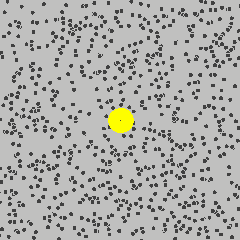It's that time again when posts will get a little more sparse as the holidays kick in. Just time for a little sciencey piece on one of Einstein's sometimes overlooked achievements from his annus mirabilis, 1905.
Atoms are like small children – they are never entirely still. It’s a remarkable contrast between the visible world, and the world of the very small. Look at a glass of water. That water appears to be motionless, yet within the liquid the water molecules are frantically dancing around.
In 1827 a Scottish botanist called Robert Brown was trying to understand plant pollination. On a microscope slide he had the pollen grains of an evening primrose plant suspended in a drop of water. When he peered through the microscope, the tiny specks of pollen jumped about, constantly in motion.
What was particularly puzzling was that there seemed to be no order to the motion, no rules for the way they moved. Instead the pollen grains’ dancing was wild, chaotic, quite different from the picture of the world as a clockwork universe, built on Newton’s laws.
When Robert Brown first saw Brownian motion he suspected it was the life source of a plant in action. It was only when he tried long-dead pollen, then stone dust and soot, finding the same effect with particles that were never alive, that he confirmed that the size of the pollen grains was responsible for their motion.This jerky dance was named Brownian motion, but remained little more than an oddity until Albert Einstein linked it to the behavior of atoms.
Einstein produced three great papers in 1905. His work on relativity and the photoelectric effect (one of the foundations of quantum theory) get the glory, but his third great paper was on Brownian motion. At least two other scientists explained Brownian motion at the same time as Einstein. Scottish-Australian scientist William Sutherland published a similar paper in 1904, but has been forgotten in the enthusiasm for Einstein’s work. Similarly, Polish scientist Marian von Smoluchowski devised a parallel explanation to Einstein’s, published in 1906, written well before he read Einstein’s paper. The timing of these papers reflected a growing understanding of matter.
Until that time, the concept of atoms was very theoretical. It's hard to believe now, but many thought they were a fiction to make calculations work. However, Einstein showed that the dance of the pollen grains was caused by the random impact of billions of water molecules, with the grains moving much as the molecules did, but vastly amplified in size. Einstein used Brownian motion to show that the liquid the grains floated in was composed of many billions of gyrating molecules.
It wasn’t until 1912, with the completion of a wide range of experiments based on Brownian motion, that French physicist Jean Perrin firmly established the existence of atoms. Until then, many scientists denied they existed.
Image from Wikipedia
Atoms are like small children – they are never entirely still. It’s a remarkable contrast between the visible world, and the world of the very small. Look at a glass of water. That water appears to be motionless, yet within the liquid the water molecules are frantically dancing around.
In 1827 a Scottish botanist called Robert Brown was trying to understand plant pollination. On a microscope slide he had the pollen grains of an evening primrose plant suspended in a drop of water. When he peered through the microscope, the tiny specks of pollen jumped about, constantly in motion.
What was particularly puzzling was that there seemed to be no order to the motion, no rules for the way they moved. Instead the pollen grains’ dancing was wild, chaotic, quite different from the picture of the world as a clockwork universe, built on Newton’s laws.
When Robert Brown first saw Brownian motion he suspected it was the life source of a plant in action. It was only when he tried long-dead pollen, then stone dust and soot, finding the same effect with particles that were never alive, that he confirmed that the size of the pollen grains was responsible for their motion.This jerky dance was named Brownian motion, but remained little more than an oddity until Albert Einstein linked it to the behavior of atoms.
Einstein produced three great papers in 1905. His work on relativity and the photoelectric effect (one of the foundations of quantum theory) get the glory, but his third great paper was on Brownian motion. At least two other scientists explained Brownian motion at the same time as Einstein. Scottish-Australian scientist William Sutherland published a similar paper in 1904, but has been forgotten in the enthusiasm for Einstein’s work. Similarly, Polish scientist Marian von Smoluchowski devised a parallel explanation to Einstein’s, published in 1906, written well before he read Einstein’s paper. The timing of these papers reflected a growing understanding of matter.
Until that time, the concept of atoms was very theoretical. It's hard to believe now, but many thought they were a fiction to make calculations work. However, Einstein showed that the dance of the pollen grains was caused by the random impact of billions of water molecules, with the grains moving much as the molecules did, but vastly amplified in size. Einstein used Brownian motion to show that the liquid the grains floated in was composed of many billions of gyrating molecules.
It wasn’t until 1912, with the completion of a wide range of experiments based on Brownian motion, that French physicist Jean Perrin firmly established the existence of atoms. Until then, many scientists denied they existed.
Image from Wikipedia


Comments
Post a Comment